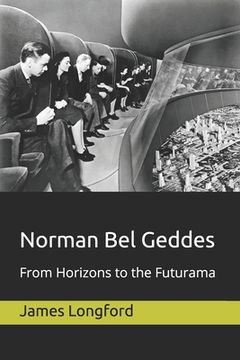Compartir
Norman Bel Geddes: From Horizons to the Futurama (en Inglés)
James Longford
(Autor)
·
Independently Published
· Tapa Blanda
Norman Bel Geddes: From Horizons to the Futurama (en Inglés) - Longford, James
$ 72.234
$ 144.468
Ahorras: $ 72.234
Elige la lista en la que quieres agregar tu producto o crea una nueva lista
✓ Producto agregado correctamente a la lista de deseos.
Ir a Mis Listas
Origen: Estados Unidos
(Costos de importación incluídos en el precio)
Se enviará desde nuestra bodega entre el
Viernes 05 de Julio y el
Viernes 19 de Julio.
Lo recibirás en cualquier lugar de Colombia entre 1 y 5 días hábiles luego del envío.
Reseña del libro "Norman Bel Geddes: From Horizons to the Futurama (en Inglés)"
In the 1920s, design began to be as important a factor in the sale of goods in the United States as utility had always been. A profession of industrial designer developed of which Norman Bel Geddes was one of the first practitioners in 1927. After the start of the Great Depression, American industry increasingly prioritized aesthetic appeal in order to stimulate sales.Geddes took the idea of streamlining, which was not new, and used it as the theme of his book Horizons (1932), so helping to propagate it across America. Originally relating only to the movement of solid matter through fluids, streamlining became symbolic of modernity in the United States and was applied even to products that did not move, thus showing it was as important metaphorically and aesthetically as it was in practical terms. The language and theoretical underpinnings of streamlining was a synthesis of scientific research, ideas related to the anti-ornamentation credo of Adolph Loos, and Evolutionary and Eugenicist theory. The Modernist slogan of form following function was also important but, in practice, streamlining just as often hid real form in pursuit of more saleable goods that were not that different on the inside from the old ones.His designs ranged from items such as furniture, drinkware, and appliances, to large projects on the borderlines of practicality that reflected his inherent showmanship, grandiosity, and lack of reverence for historical precedent. Modularity and model-making recur throughout his work. He gave his ideas an aura of inevitability and the sense that they were the logical result of existing trends and technology. They were just within the grasp of the contemporary imagination and for a future that would arrive soon. He said he was no Jules Verne and never admitted that anything he designed was impossible.This book covers the critical phase of his career from the publication of Horizons to his design for the Futurama at the 1939 New York World's Fair, examining his key works of that period and placing them in context within his career and against the background of inter-war American design.
- 0% (0)
- 0% (0)
- 0% (0)
- 0% (0)
- 0% (0)
Todos los libros de nuestro catálogo son Originales.
El libro está escrito en Inglés.
La encuadernación de esta edición es Tapa Blanda.
✓ Producto agregado correctamente al carro, Ir a Pagar.

